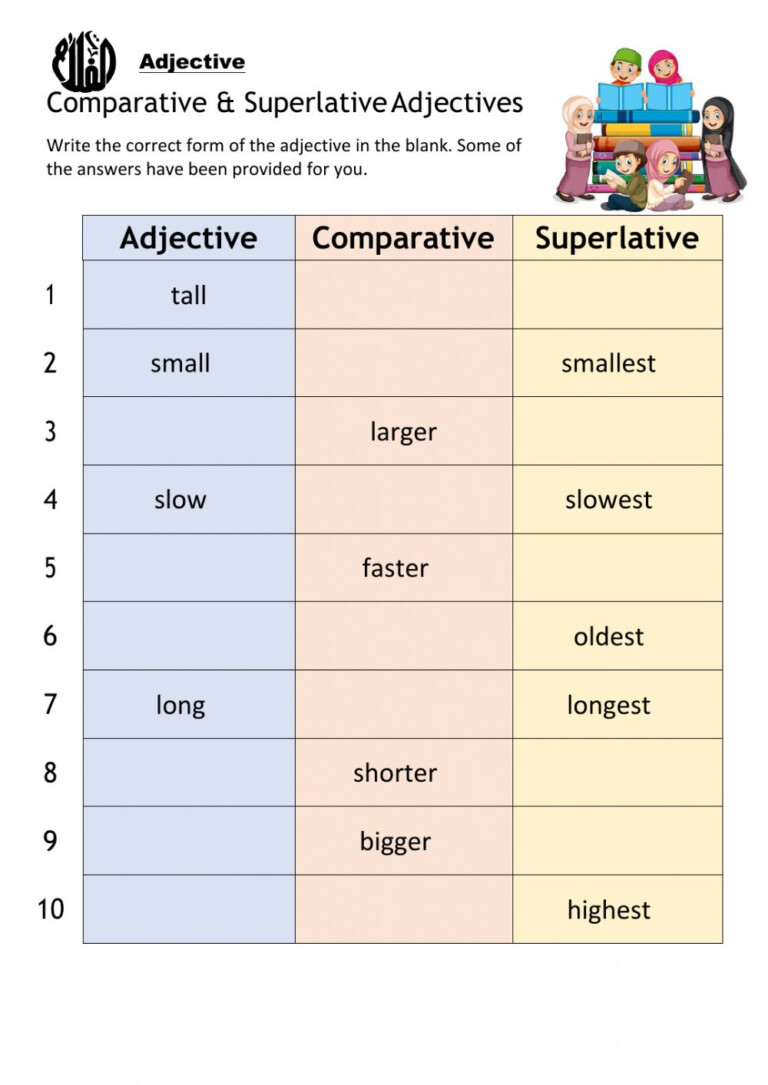
Elevating Grammar Learning: The Transformative Power of Comparative and Superlative Game Worksheets
Grammar, often perceived as a dry and arduous subject, forms the foundational bedrock of effective communication. Among its many intricate rules, the proper application of comparative and superlative adjectives and adverbs stands out as crucial for nuanced expression. Yet, teaching these concepts can often lead to glazed-over eyes and rote memorization rather than genuine understanding. This is where the innovative approach of integrating comparative and superlative game worksheets emerges as a game-changer, transforming mundane lessons into dynamic, engaging, and highly effective learning experiences.
This comprehensive article will delve into the profound benefits, diverse types, and practical implementation strategies of utilizing comparative and superlative game worksheets in educational settings. We will explore how these resources not only enhance comprehension and retention but also foster a love for language learning, making grammar an adventure rather than a chore.
The Pedagogical Power of Play: Why Games Work

At its core, game-based learning taps into our innate human desire for challenge, interaction, and reward. When applied to grammar, this translates into a powerful pedagogical tool:

- Enhanced Engagement and Motivation: Games inherently capture attention. The element of fun, competition (friendly), and immediate feedback keeps learners invested and eager to participate, a stark contrast to traditional lecture-and-drill methods.
- Contextualized Learning: Unlike isolated grammar exercises, games often place language in meaningful contexts. Learners use comparatives and superlatives to describe, compare, and contrast real or imagined scenarios, solidifying their understanding of when and why to use these forms.
- Active Participation and Practice: Games demand active participation. Students aren’t passively receiving information; they are actively applying rules, making decisions, and producing language. This repeated, active practice is vital for skill mastery.
- Reduced Anxiety and Risk-Taking: A playful environment lowers the stakes. Mistakes become learning opportunities rather than failures, encouraging students to experiment with language without fear of judgment.
- Improved Retention: Information learned through engaging, multi-sensory experiences is more likely to be remembered. The emotional connection forged during a fun activity reinforces memory pathways.
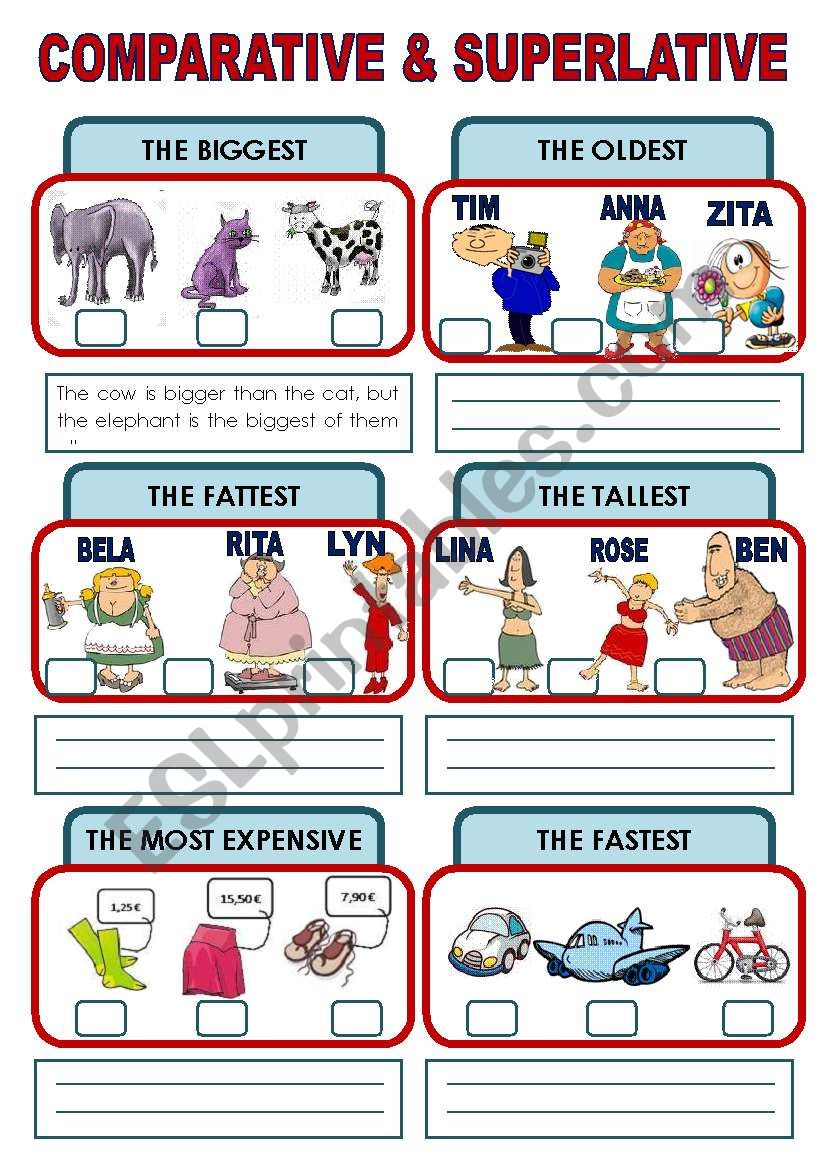
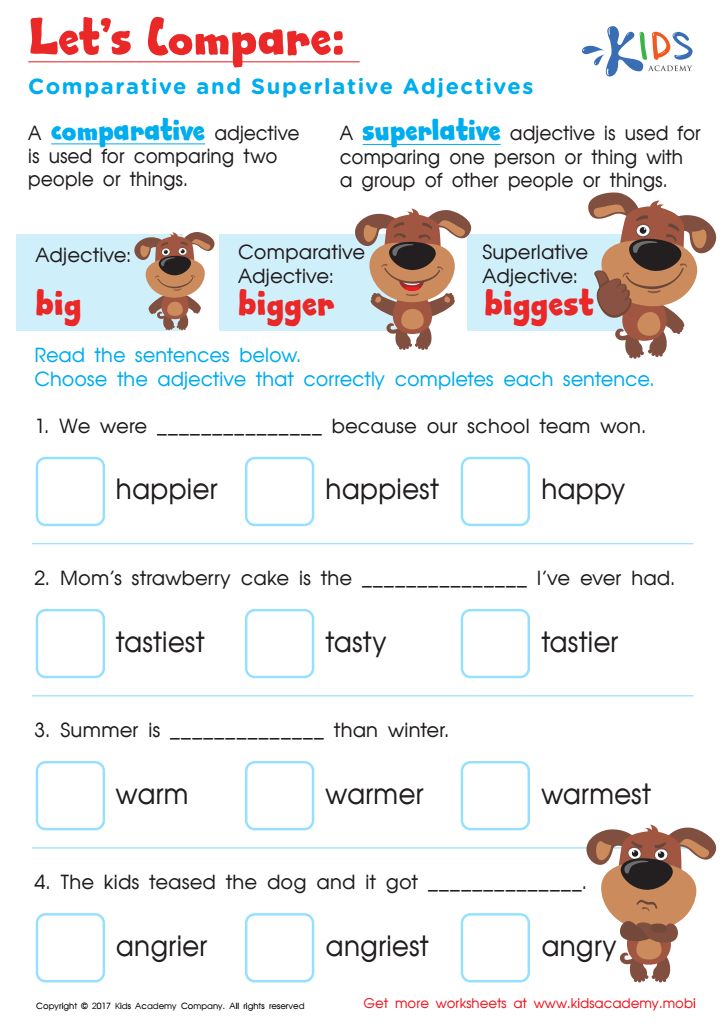

Diverse Types of Comparative and Superlative Game Worksheets
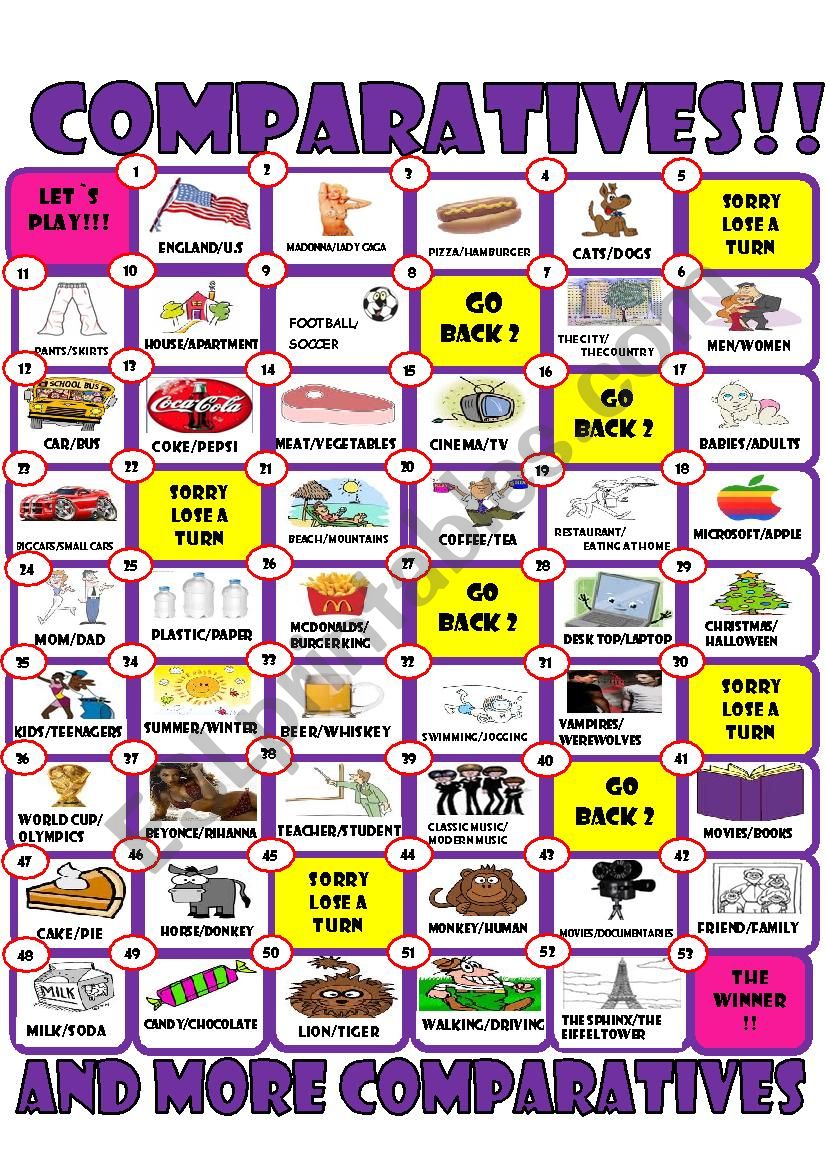
The beauty of comparative and superlative game worksheets lies in their incredible versatility. They can be adapted for various age groups, proficiency levels, and learning styles. Here are several effective types:
1. Picture Description & Comparison Worksheets:

- Concept: Students are presented with two or more images (e.g., different animals, houses, people).
- Game Element: They must compare and contrast elements using comparative and superlative adjectives/adverbs (e.g., "The elephant is bigger than the mouse," "The cheetah is the fastest animal").
- Variations: "Spot the Difference" games where students describe differences using comparatives, or "Who Am I?" where one student describes a character using superlatives and others guess.

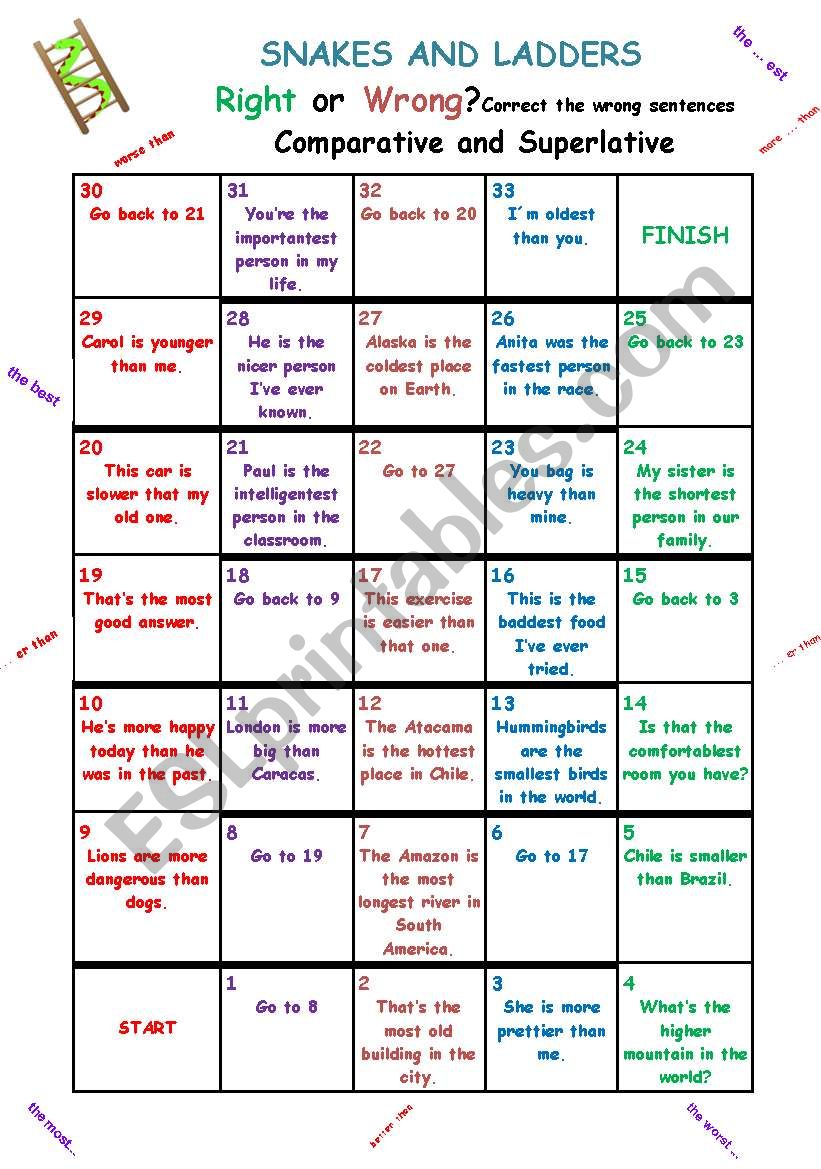
2. Sentence Transformation Races:
- Concept: Students are given base sentences (e.g., "The car is fast").
- Game Element: They race against a timer or other teams to transform the sentence into a comparative or superlative form (e.g., "The car is faster than the bike," "The car is the fastest in the race").
- Variations: Add a rule that they must use a specific adjective/adverb, or combine two simple sentences into one comparative statement.
3. Trivia & Fact-Finding Games:
- Concept: Worksheets present questions that require superlative answers based on general knowledge.
- Game Element: "What is the highest mountain?", "Which is the longest river?", "Who is the richest person?". Students research or recall facts to complete sentences using superlatives.
- Variations: Students create their own trivia questions for peers, fostering deeper engagement and research skills.
4. Role-Play & Dialogue Prompts:
- Concept: Worksheets provide scenarios or character profiles.
- Game Element: Students work in pairs or small groups to create dialogues using comparatives and superlatives. For instance, comparing two restaurants, two movies, or two holiday destinations.
- Variations: "Debate Club" worksheets where students argue for the "best" or "worst" of something, using persuasive comparative and superlative language.
5. Board Game Worksheets:
- Concept: A printable board game with spaces containing grammar prompts.
- Game Element: Players roll a die, move their token, and complete the grammar task on the space (e.g., "Complete with a comparative: ‘My brother is ____ (tall) me.’"). Landing on certain spaces might require them to form a superlative sentence or lose a turn.
- Variations: "Snakes and Ladders" where correct answers allow them to climb, and incorrect ones send them down.
6. "Find Someone Who…" Activities:
- Concept: Worksheets list prompts requiring students to find classmates who fit certain comparative or superlative descriptions.
- Game Element: "Find someone who is taller than you," "Find someone who has the longest hair," "Find someone who runs faster than you." Students mingle and ask questions using the target grammar.
- Variations: Students interview each other to find the "most interesting hobby," the "best singer," etc., among their peers.
7. Creative Writing & Story Starters:
- Concept: Worksheets provide open-ended prompts or beginnings of stories.
- Game Element: Students must continue the story, ensuring they incorporate a specified number of comparative and superlative forms. For example, "Write a story about the most adventurous trip you ever took…" or "Compare two mythical creatures in a short paragraph."
- Variations: "Chain Story" where each student adds a sentence, building on the previous one and incorporating a C&S form.
Key Benefits of Integrating Game-Based Worksheets
Beyond the immediate engagement, the strategic use of comparative and superlative game worksheets offers long-term pedagogical advantages:
- Reinforcement and Review: Games provide repeated exposure to the target grammar in varied contexts, solidifying understanding and aiding recall. They are excellent for reviewing previously taught concepts.
- Differentiation Made Easy: Many game worksheets can be easily adapted to different proficiency levels. Beginner students might focus on simple comparisons, while advanced learners can tackle more complex structures or irregular forms.
- Promotion of Collaborative Learning: Many games are designed for pairs or small groups, fostering communication, peer teaching, and problem-solving skills. Students learn from each other’s mistakes and successes.
- Assessment in Disguise: Teachers can informally assess student understanding during game play. Observing interactions and checking completed worksheets provides valuable insight into areas of mastery and difficulty without the pressure of a formal test.
- Development of Critical Thinking: Comparing and contrasting requires students to analyze information, make judgments, and articulate their reasoning using appropriate language.
- Vocabulary Expansion: Games often introduce new adjectives and adverbs, enriching students’ lexicon naturally as they describe and compare.
Crafting and Selecting Effective Comparative and Superlative Game Worksheets
To maximize the impact of these resources, educators should consider several factors when designing or choosing comparative and superlative game worksheets:
- Clear Learning Objectives: What specific comparative/superlative forms are you targeting? (e.g., regular adjectives, irregular adjectives, adverbs).
- Age and Proficiency Appropriateness: The complexity of vocabulary, sentence structures, and game rules must align with the students’ developmental stage and language level.
- Clarity of Instructions: Simple, unambiguous instructions are crucial for smooth gameplay and independent learning. Visual cues can be particularly helpful.
- Balance of Challenge and Success: The game should be challenging enough to be interesting but not so difficult as to be frustrating. Achieving a sense of accomplishment is key to motivation.
- Visual Appeal: Well-designed worksheets with appealing graphics, clear layouts, and sufficient space for writing enhance engagement.
- Varied Activities: Incorporate a mix of listening, speaking, reading, and writing tasks to cater to diverse learning styles and ensure comprehensive skill development.
- Adaptability: Can the worksheet be used for individual work, pairs, or groups? Can it be easily modified for different levels?
- Inclusion of Answer Keys: For self-correction or quick teacher grading, an answer key is invaluable.
Integrating Worksheets into the Curriculum
Comparative and superlative game worksheets are incredibly versatile and can be incorporated at various stages of a lesson or unit:
- Warm-up/Review: A quick game worksheet at the beginning of a class can activate prior knowledge or review previously taught concepts, setting the stage for new learning.
- Main Activity: The core of a lesson can be built around a more extensive game worksheet, allowing for deep practice and application of the grammar rules.
- Reinforcement/Practice: After introducing new concepts, a game worksheet provides an immediate opportunity for students to practice and consolidate their understanding.
- Homework: Assigning a game worksheet for homework can make out-of-class practice more enjoyable and effective than traditional exercises.
- Assessment: While not formal tests, completed game worksheets can serve as informal assessments, allowing teachers to gauge individual and group understanding.
- Extension Activities: For early finishers or advanced learners, more challenging game worksheets can provide additional practice and intellectual stimulation.
Addressing Potential Challenges and Maximizing Impact
While highly beneficial, implementing game-based worksheets does come with a few considerations:
- Preparation Time: Creating or finding high-quality game worksheets can be time-consuming. However, many excellent resources are available online (e.g., ESL teaching websites, educational marketplaces). Investing time upfront can save time in the long run.
- Classroom Management: Some games might generate more excitement and noise. Clear rules, consistent expectations, and effective grouping strategies are essential for maintaining a productive learning environment.
- Differentiation: While adaptable, ensuring every student is appropriately challenged requires careful planning. Providing tiered options or allowing students to choose their level of difficulty can be helpful.
- Resource Availability: Printing costs or access to technology (for digital versions) might be a factor. Creative solutions like laminating and reusing worksheets or projecting them for whole-class activities can mitigate this.
Conclusion
The journey of mastering comparative and superlative forms doesn’t have to be a monotonous trek through grammar drills. By embracing the power of play, educators can transform this vital aspect of language learning into an engaging, effective, and enjoyable experience. Comparative and superlative game worksheets offer a dynamic pathway to deeper comprehension, improved retention, and increased student motivation.
From lively board games to interactive picture comparisons and creative writing challenges, these worksheets provide a rich tapestry of opportunities for students to actively apply and internalize complex grammatical rules. As we continue to seek innovative pedagogical approaches, the strategic integration of comparative and superlative game worksheets stands out as a clear example of how blending fun with focused learning can yield truly remarkable results in the language classroom. Embracing these resources is not just about teaching grammar; it’s about igniting a passion for language and equipping students with the confidence to communicate with greater precision and fluency.
